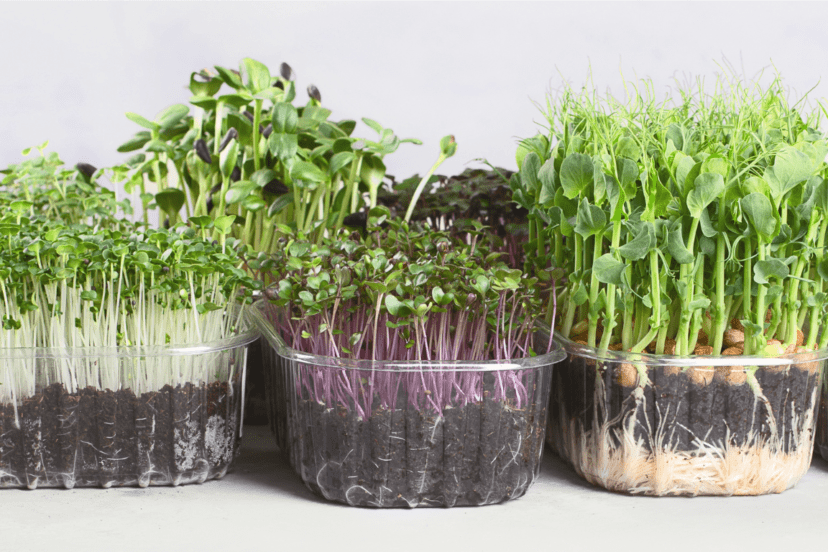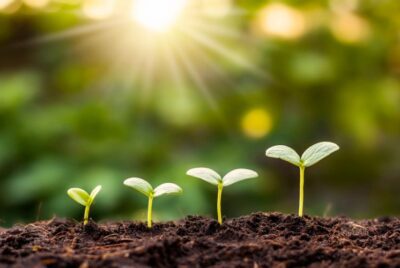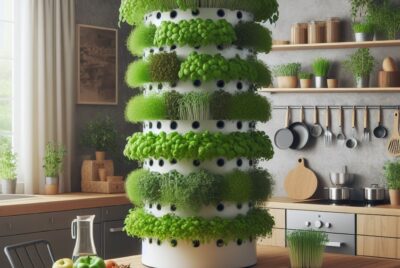Comparing Hydroponic Growing Medium for Microgreens
As an enthusiast in the realm of microgreen cultivation, I understand the importance of choosing the right growing medium. In this article, I will guide you through the different types of soil mixes suitable for microgreen cultivation and explain the advantages and disadvantages of using hydroponic systems for microgreens. Additionally, I will highlight various hydroponic growing medium and provide helpful suggestions for your consideration.
Introduction
Microgreens have gained immense popularity in recent years, thanks to their nutrient density and versatility in culinary applications. These tiny greens, harvested at an early stage of growth, pack a powerful punch of flavor and nutrients. However, to ensure a successful harvest, it’s crucial to start with the right growing medium.
Traditional Soil Mixes for Microgreens
When it comes to microgreen cultivation, traditional soil-based methods have been a go-to choice for many growers. These mixes often consist of a combination of potting soil, compost, and other organic matter. While they provide a familiar environment for plants, they come with their own set of pros and cons.
One of the advantages of using traditional soil mixes is their natural nutrient content, which can support healthy growth. However, they may also introduce the risk of soil-borne diseases and pests, requiring careful monitoring and management.
Hydroponic Systems for Microgreens
On the other hand, hydroponic systems for microgreens offer an innovative approach to growing microgreens without the need for traditional soil. This method involves growing plants in a nutrient-rich water solution, providing them with essential elements for growth.
Hydroponic systems have gained popularity for their efficiency and sustainability. They allow for precise control over nutrient levels and water delivery, resulting in faster growth rates and higher yields. Additionally, hydroponic systems reduce the risk of soil-borne diseases, creating a cleaner and more controlled growing environment.

In the next sections, we’ll delve into the specific types of hydroponic growing media and their benefits for microgreens. Whether you’re considering coco coir, rockwool, perlite, expanded clay pellets, or vermiculite, each option comes with its own set of advantages.
Advantages of Using Hydroponic Systems
Increased Growth Rates and Yields
One of the primary benefits of utilizing a hydroponic system for microgreens is the remarkable increase in growth rates and yields. Without the limitations of soil structure and composition, plants can access nutrients more efficiently, leading to accelerated growth. This means you can enjoy a bountiful harvest of fresh microgreens in a shorter time frame. With hydroponics, you’ll witness your greens thriving, reaching maturity swiftly, and providing you with a continuous supply of nutrient-rich delicacies.
Reduced Risk of Soil-Borne Diseases
Traditional soil-based methods can sometimes be plagued by soil-borne diseases and pests that hinder plant growth. In contrast, hydroponic systems eliminate this risk altogether. By providing a sterile and controlled environment, hydroponics ensure that your microgreens thrive without the threat of soil-related ailments. This translates to healthier, disease-resistant plants, allowing you to focus on nurturing their growth and maximizing your harvests without the constant worry of potential soil-borne issues.
Water Conservation and Efficient Nutrient Uptake
Hydroponic systems are inherently water-efficient, making them an environmentally conscious choice for growers. The closed-loop nature of these systems allows for the recirculation of water, minimizing waste. Additionally, the precise delivery of nutrients directly to the plant roots ensures optimal uptake, reducing the overall resource consumption. This eco-friendly approach not only saves water but also minimizes nutrient wastage, contributing to a sustainable and efficient microgreen cultivation process. With hydroponics, you’re not just growing greens; you’re doing so with a mindful eye on environmental impact.
Choosing the Right Hydroponic Growing Medium
When it comes to hydroponic microgreen cultivation, selecting the appropriate growing medium is crucial for success. Each type of hydroponic media offers unique characteristics that can impact plant growth and development. Let’s explore three popular options: coco coir, rockwool, and perlite.
Coco Coir as a Hydroponic Growing Medium
Coco coir, derived from coconut husks, has gained popularity as a sustainable and versatile hydroponic medium. It offers excellent water retention and aeration properties, creating an ideal environment for microgreen roots to thrive. Additionally, coco coir is naturally disease-resistant, providing an extra layer of protection for your plants. Its fibrous texture provides stability for delicate microgreens, enabling them to establish robust root systems. With coco coir, you’re not only providing a nurturing medium but also contributing to sustainable and eco-friendly cultivation practices.
To effectively use coco coir in your hydroponic system, ensure it is properly hydrated before planting. Its fibrous texture provides a stable anchor for microgreens, allowing them to establish strong root systems.
Rockwool as a Hydroponic Growing Medium
Rockwool, made from molten rock spun into fibers, is another popular choice for hydroponic microgreen cultivation. It provides excellent air porosity and moisture retention, creating an optimal balance for root development. Rockwool cubes or slabs are commonly used to support microgreen growth. Before using rockwool, it’s essential to pre-soak it and adjust the pH levels to ensure an optimal growing environment. This extra step ensures that your microgreens receive the perfect start, with a medium that encourages vigorous root growth and healthy development.
Before using rockwool, it’s essential to pre-soak it and adjust the pH levels to ensure an optimal growing environment. This helps prevent any potential nutrient imbalances that could affect plant health.

Perlite as a Hydroponic Growing Medium
Perlite, a volcanic glass that expands when heated, is known for its exceptional aeration properties. It promotes healthy root development by ensuring an oxygen-rich environment around the roots. Perlite is lightweight and easy to work with, making it a convenient choice for hydroponic setups. When using perlite, ensure it is adequately rinsed to remove dust particles. This will prevent any potential clogging of the hydroponic system and allow for efficient nutrient delivery. With perlite, you’re providing an environment where roots can thrive, ensuring optimal nutrient absorption and healthy, vigorous growth for your microgreens.
When using perlite, ensure it is adequately rinsed to remove dust particles. This will prevent any potential clogging of the hydroponic system and allow for efficient nutrient delivery.
Other Hydroponic Medium Options
In addition to coco coir, rockwool, and perlite, there are a couple of other hydroponic growing media worth considering for microgreen cultivation.
Expanded Clay Pellets
Expanded clay pellets, also known as hydroton or clay pebbles, are lightweight, pH-neutral, and provide excellent aeration. They are ideal for supporting plant roots in hydroponic systems. Additionally, they can be reused, making them a sustainable option. Their porous structure allows for optimal root oxygenation and water retention, creating an environment where microgreens flourish. With expanded clay pellets, you’re not only investing in a medium that promotes healthy root systems but also contributing to a more sustainable and eco-conscious approach to microgreen cultivation.
Vermiculite
Vermiculite is a mineral-based growing medium known for its ability to retain water and improve soil structure. While it can be used in hydroponics, it’s important to note that vermiculite is not as commonly used for microgreen cultivation in hydroponic systems as other options like coco coir or rockwool. Its water-holding capacity makes it suitable for traditional soil-based methods. However, in hydroponics, it may require careful monitoring to avoid over-saturation. If you’re exploring diverse growing methods, vermiculite could be an intriguing option for your microgreen cultivation endeavours.
Personal Recommendations for Hydroponic Media
When it comes to choosing the best hydroponic growing medium for your microgreens, it’s essential to consider your specific growing conditions and preferences. If you’re looking for a sustainable option with natural disease resistance, coco coir is an excellent choice. For optimal aeration and moisture retention, rockwool provides a reliable medium. Perlite, with its lightweight and airy structure, offers convenience in handling. If you’re inclined towards reusability and sustainability, expanded clay pellets could be your go-to medium. For those interested in exploring alternatives, vermiculite’s water-retention properties may intrigue you. Remember, the ideal medium depends on your unique growing environment and goals.
Conclusion
In the world of microgreen cultivation, the choice of growing medium can make all the difference. Traditional soil mixes offer familiarity and natural nutrient content, but come with potential risks of soil-borne issues. On the other hand, hydroponic systems revolutionize the process, providing precise control over nutrients, reduced disease risks, and efficient resource use.
Among the hydroponic options, coco coir, rockwool, and perlite each bring their unique benefits to the table. Whether you prefer the natural, disease-resistant properties of coco coir, the excellent air porosity of rockwool, or the lightweight aeration of perlite, there’s a medium to suit every grower’s preferences.
Additionally, expanded clay pellets and vermiculite offer alternative choices for those looking to explore further. Their specific properties can cater to different growing conditions and preferences.
Ultimately, the best medium for your microgreen venture will depend on your goals and the environment you’re working in. Remember, experimentation is key. By trying out different mediums and observing their impact on your microgreens, you’ll gain valuable insights that can lead to even greater success in your cultivation journey. Happy growing!
FAQs
1. How often should I water microgreens in a hydroponic system?
The frequency of watering will depend on factors like temperature, humidity, and the type of hydroponic system you’re using. Monitor the moisture levels and adjust accordingly to keep the roots healthy.
2. Can I reuse hydroponic growing media?
Yes, many hydroponic media options can be reused with proper cleaning and sterilization. This can help reduce waste and save resources in the long run
3. What are some common mistakes to avoid when using hydroponic systems for microgreens?
Avoid over-fertilizing, neglecting pH levels, and not providing adequate aeration. Additionally, ensure proper sanitation practices to prevent the spread of diseases.
4. Are there any specific nutrients I should use for hydroponic microgreen cultivation?
A balanced nutrient solution with essential elements like nitrogen, phosphorus, and potassium, as well as micronutrients, is crucial for healthy microgreen growth.
5. What are the long-term benefits of choosing a hydroponic system for microgreens?
In the long run, hydroponic systems can lead to higher yields, reduced water usage, and a more controlled growing environment, ultimately contributing to sustainable and efficient microgreen production.




